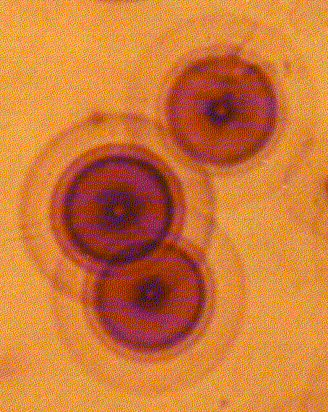

.. the Genesis record of creation week and the subsequent events of the world-wide flood encompass, in addition to the primordial created rocks such as the Precambrian granites, the formation of pristine sedimentary rocks, lava-like rocks, the intrusion of granite-like rocks into pristine sedimentary rocks, and almost unlimited possibilities at the times of the flood... That model includes the possibility that some granites may have been created an Day 1 adjacent to and immediately after same primordial or pristine ‘sedimentary’ rocks were created ... Investigation an a case by-case basis is needed before it can be decided whether something called 'Precambrian' can be connected to the events of creation week (Gentry, 1986 p. 302)
(Po218 in Biotite, from Creation's Tiny Mystery by R.V. Grentry)
When I first read Gentry’s works, I was quite surprised and pleased to find that the two last Canadian sites mentioned in his papers (Gentry, 1971 and 1974) are only a two-hour drive from my home. They are located in the late Proterozoic Grenville Supergroup of the Precambrian Canadian Shield. The Precambrian is divided into two main eras, the Archean (4,500?? Ma to 2,500Ma), and the Proterozoic (2,500 Ma to 570 Ma). Each of these eras has been subdivided into observable events such as large-scale metamorphic activity or sedimentary and volcanic deposition.
I found the location of the first site above, the Fission Mine, by asking the staff of one of the museums who had sent Gentry biotite samples (sample number 30996. National Museum of Canada. L. Moyd, National Museum, Ottawa, Personal communications, April and August 1987). Nowhere does Gentry describe this site, but it lies within rocks of the Grenville Supergroup. In his book Gently mentions only the one site, the Silver Crater Mine. He does mention other places, like Norway, New Hampshire, and Madagascar, but only in a general way. Among geologists it is standard geological practice to provide precise locations and formation names for each sample. Unfortunately, Gentry has not done so. This is rather strange in a book whose avowed intent is to explain and justify an important claim. Why were specific site locations, save one, omitted?
Before learning the locations of two of the sites, I suspected that Gentry had used samples from the Superior Province of Archean age in northern Ontario because this Province has some of the oldest rocks in North America. Thus, I was surprised to find that his sites were located in the much younger Grenville Province. This is a major blunder an Gentry’s part. Louis Moyd made this very point to Gentry in person, when Gentry visited to get samples (Moyd, personal communication, February 1987). It is apparent that Gentry knows next to nothing about Precambrian geology because he lumps all Precambrian rocks into one unit -- the created one.
The Grenville Supergroup is a very complex succession of metasediments, metavolcanics, alkalic intrusive rocks, mafic intrusive rocks and granitic intrusive rocks. It is located in a region of low- (greenschist) to high-grade (upper amphibolite) metamorphism that has altered many of the igneous, sedimentary and volcanic rocks into recrystallized rock called gneiss. However. many original igneous, sedimentary and volcanic features are preserved. Hydrothermally altered rocks are also common as are metasomatic rocks (wall-rocks the have been included within and altered by intrusive melts). The metavolcanics (the lowermost rock units in the Supergroup) consist of pillow lavas (indicative of underwater extrusion), breccias (fragmented lavas), tuffs and pyroclastics, all of which have been altered to varying degrees by metamorphism. The intrusive rocks consist of a variety at types, including gabbro, granite, diorite, nepheline syenite, and pegmatite. Many, but not all, of the intrusive rocks have been altered by low-grade metamorphism. The minerals in which Gentry found the Po halos are biotite and fluorite.
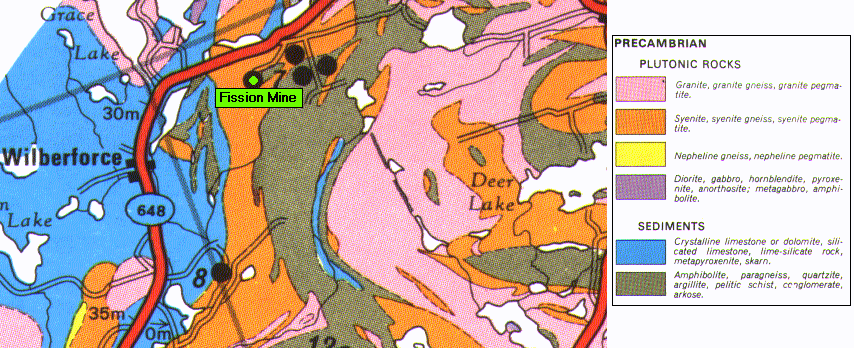
The Fission (also known as the Richardson) Mine is located two km east of Wilberforce on lot 4, concession XXI, Cardiff Township (45.015 degrees N latitude; 78.194 degrees W longitude) (see Figure 1), and consists of a single abandoned adit driven into a hill. The surface geology is shown in Figure 2 [Photos of the vein-dike in Figures 2a,b]. This one is a much-used mineral-collecting locality for apatite, biotite, radioactive minerals and fluorite. The following geological description at this site is taken from the International Geological Congress Guidebook for Field Excursion A47 -C47.
"The country-rocks are variably syenitized biotite-gneisses and amphibolites, underlain by a thick series of partly silicated marbles. The altered gneisses are of many types... The main deposit consists of a series of closely spaced vein-dikes... Most of the vein-dikes are more or less conformable with the structures of the enclosing gneisses, but some transect these structures. The bodies are extremely irregular in shape, thickness, and extent. Some of the individual vein-dikes exceed 300 feet in length, with maximum thickness of more than 10 feet.
"Last in this sequence [of rock units] are the vein-dikes, in which the core zone constitutes a substantial proportion of the whole mass. The bodies are generally more or less tabular, with crystals projecting inward from the walls. Some of the crystals are partly cavernous and enclose semi-isolated masses of the core-materials. Others may be more nearly euhedral, but contain completely isolated, rounded pellets of core-minerals . . . - calcite, fluorite, or mixtures of both.
"The composition and structure of these vein-dikes indicate origin by hydro-thermal "fluxing" and recrystallization of wall rocks along bedding planes, joins, and other fractures. The abrupt termination of the vein-dikes,..., strongly favours such an origin - the hanging-wall [top of dike] curving around to become the footwall [floor of dike].
"Uraninite occurs as cubic crystals and also as irregular masses. It is very erratic in distribution and can be found in various associations... Most fluorite is the deep purple variety, antozonite. …smells of fluorine and ozone when crushed or abraded, all of which reflect radiation damage. The depth of colour of the fluorite is an indicator of the proximity of uraninite." (Hogarth, D.D., Moyd,L., Rose, E.R., and Steacy, H.R., 1972).
From this description it is clear that this is a small calcite vein-dike, a rock body containing mostly large crystals of calcium carbonate and other minerals like mica. Gentry's sample came from the vein lining. The biotite grew outward from the syenitized wall rock, replacing the calcite, (see Figure 13) as a result of reactions between the wall rock, the calcite core and volatile fluids. (Moyd, personal communication, August 1987).
The vein-dike is small in length and width, it cuts metasedimentary rocks which still retain bedding planes, and radioactive minerals abound. In another mineral-collecting guidebook (Sabina,1986, p. 79), it was noted that at this site "Uraninite was found in cavities in pegmatites with magnetite, mica or calcite-fluorite intergrowths." Clearly, radioactive minerals are common at this locality. Percolating water from the hill the deposit occurs within is strongly radioactive and was sold in the 1920s for therapeutic purposes. Hornblende crystals 2 m long, biotite 0.3 cm across, apatite 0.3 cm long, feldspars 1 m long, and zircons 5 cm long have been found in this deposit. Also mentioned are pegmatites completely surrounded by metasediments and derived from partial melting of those metasediments during metamorphism.
[See Figure 14 for photos of a calcite vein-dike near the Fission Mine.]
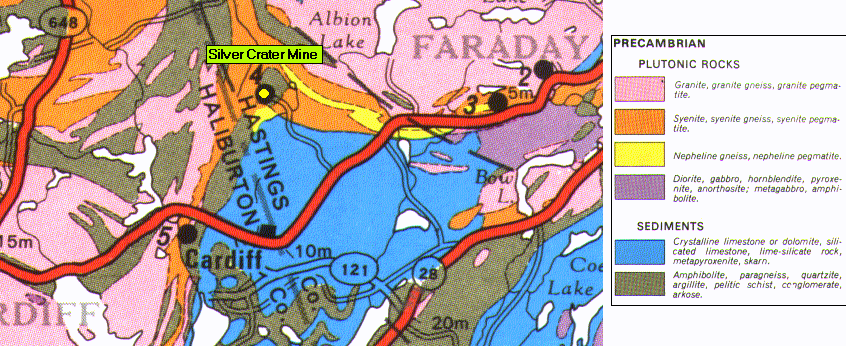
The Silver Crater (Basin) Mine is located 12 km west of Bancroft on lot 31, concession XV, Faraday Township (45.031 degrees N latitude; 78.008 degrees W longitude), 3 km north of the settlement of Monck Road (see Figure 1). This abandoned mine consists of an adit with some drifts and a raise. The surface geology of the mine is shown on Figure 3. The calcite vein-dike body here was mined for its biotite content. It was from this locality that the mica containing Gentry's "spectacle" halo which "...exhibits true radiohalo characteristics" was collected.
The geology of the Silver Crater Mine site is similar to the geology of the Fission site, and the calcite vein-dike is part of the same group of calcite vein-dikes that dot the countryside near Bancroft. Following is how D.F. Hewitt (1957) of the Ontario Department of Mines (now the Ontario Geological Survey) described the mine:
"The [calcite vein-dike] body occurs in a small band of amphibolite lying in syenitic and nepheline syenite gneiss in the trough of a V-shaped south-pitching syncline between the Cardiff plutonic complex on the west and the Faraday granite sheet on the east.
"The [calcite vein-dike] body consists of a coarse-grained calcite (1-5 inches in size), containing accessory black mica (lepidomelane [high mafic biotite]) in books up to 2 feet in diameter.
"Contacts of the [calcite vein-dike] body with the enclosing biotite amphibolite gneiss are irregular, and long inclusions of gneiss extend into the [calcite vein-dike]. Tongues of the wall-rock gneiss finger out into interfingering tongues of carbonate.
"This deposit has some features characteristic of the metasomatic replacement deposits in marble, of the hydrothermal calcite-apatite-fluorite vein deposits, and of intrusive carbonate deposits. Its mode of origin is in dispute.
"The coarse pegmatitic crystallization of the calcite, black mica, hornblende, and albite suggest crystallization from a fluid medium, rich in volatiles. … The wall-rock alteration, involving addition of fluorine, carbon dioxide, and soda into the surrounding wall-rock, favours crystallization of the [calcite vein-dike] body from a fluid state, such as a carbonate intrusive or hydrothermal solution.
"The orientation of the apatite and biotite suggests flowage after crystallization. The irregular replacement of the wall-rock gneiss and the long relic bands of biotite amphibolite in the [calcite vein-dike] indicate metasomatic replacement of the wall-rock gneiss by [calcite vein-dike].
"The author believes that the [calcite vein-dike] has originally been largely derived from marble, but that it has been assimilated or dissolved and recrystallized from hot solutions rich in fluorine and soda. This would account for the extensive wall-rock alteration and the metasomatic type of replacement of wall-rock gneiss, without disturbance of relict mafic gneiss bands. Such relict bands are incompatible with an origin of the [calcite vein-dike] body involving tectonic movement of a marble bed in a plastic state. The author feels that the deposit is therefore best classed as a special variety of hydrothermal deposit in which the solutions have carried out extensive metasomatic replacement of the wall-rocks."(Hewitt, 1957, p. 77-78)
Let me make one thing very clear at this point. The Silver Crater and the Fission Mine dikes are not granites at all. The composition and mode of origin is totally wrong for a granite and Gentry has made a major error in identifying the source rocks of his biotite as granites. In his book Gentry erroneously criticizes Dalrymple for comparing the textures of basaltic lava and granite (Gentry, 1986,p. 130), yet Gentry can't tell the difference between granite and calcite vein-dike rock.
Recently a consensus has emerged among geologists as to the origin of the calcite vein-dike material, the biotite, and the other large mineral grains in the dikes. Because of the presence of rounded calcite within the biotite, it is thought that the biotite grew as a replacement within the solid calcite vein-dike matrix. This process occurs when vein-dike, which was hydrothermally deposited or injected as a molten liquid, is reheated enough to cause the evenly distributed biotite, hornblende, betafite, apatite, and so forth, in the wall-rock in the calcite vein-dike to start to migrate and form larger crystals in the calcite vein-dike.
Gentry claimed that "Halos occur in many mica samples which have not undergone metamorphism of any kind' (1986. p- 299). In fact, however, these micas were indeed formed during metamorphism at moderate depth (10-15 km), and overburden has since been removed by erosion. To put it simply and directly, the biotite was metamorphically derived.
[See Figure 15 for photo of biotite at Silver Crater Mine]
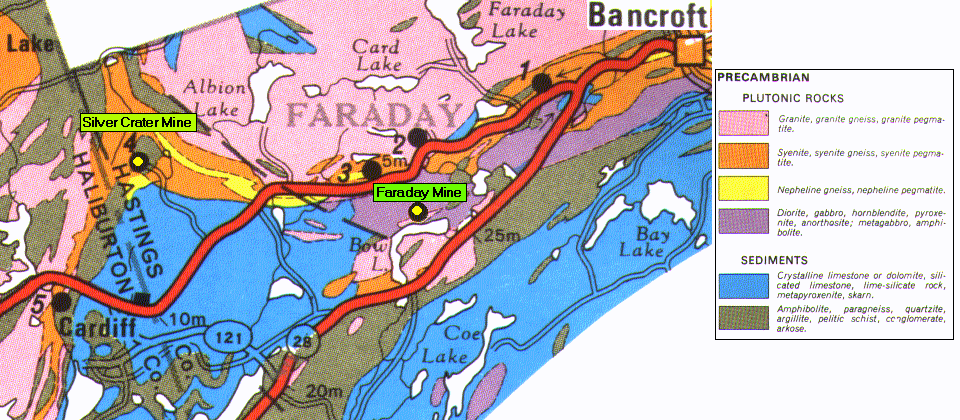
The Faraday (now called the Madawaska) Mine is located 5 km west of Bancroft on Highway #28 on the northeast end of Bow Lake (77.925 degrees N latitude; 45.004 degrees W longitude) (see Figure 1). The mine workings consisted of several adits, drifts, and several levels. Figure 4 shows the surface geology at this site [See Figures 8, 9, 10, 11 for photos]. The mine was opened for the uranium in a granite pegmatite, which cuts a gabbro/metagabbro intrusive body, which itself cuts metasedimentary rocks, including marble. In the early 1950s Jack Satterly mapped the Bancroft area specifically for radioactive minerals. Here is how Satterly described the geological setting of the Faraday Mine in the Ontario Department of Mines report for 1956.
"The radioactive minerals occur in bodies of ieucogranite, pegmatite. and pyroxene granite (or syenite) pegmatite, cutting metagabbro and gabbroic amphibolite. The metagabbro and amphibolite form the western part of the Faraday metagabbro, a metamorphosed basic intrusive body about 6 miles in length and up to 3/4 mile wide, which cuts the Grenville metasediments, chiefly marble, amphibolite, and paragneiss in this area. Inclusions and relict bands of marble and metasedimentary amphibolite occur in the metagabbro... The Grenville metasediments and the Faraday metagabbro are intruded by nepheline syenite, syenite and granite. ...the metagabbro itself is strongly affected by dynamic metamorphism and shearing.
"Structurally, the granitic [pegmatite] bodies of the Faraday intrude the metagabbro, which lies in the mixed hybrid gneiss zone that forms the hanging wall of the Faraday granite sheet. These bodies may be related genetically to the latter intrusive" (Satterly, 1956, p. 110)
In other words, material was eroded from some preexisting rock, deposited as a sedimentary rock (probably in a volcanic island arc setting (Windley, 1986)), then deformed and recrystallized by high-grade metamorphism (referred to as the Grenville Orogeny (Lumbers, 1982)) which altered this rock to paragneiss. The paragneisses were in turn intruded by the gabbro, which later underwent a metamorphic episode during the latter stages of the orogeny. Finally, the rocks were intruded by the granite pegmatite. Gentry’s biotite came from this pegmatite.
S.L. Masson and J.B. Gordon note of the pegmatites of the mine:
"Pegmatites hosting uranium mineralization intrude the metasediments. metagabbro and pyroxinite. They generally conform to foliation but locally cross-cut it. Pegmatites masses are 91.5 to 915 m long, 3 to 46 m wide and some extend down dip more than 300 m.... The pegmatite is composed of feldspar, hornblende-chlorite, quartz, calcite, magnetite and zircon. Main accessory minerals are [biotite] mica, titianite, apatite, allanite tourmaline, uraninite, uranophane and uranothorite."
A.R Bullis (1975. P. 717), writing on the geology of the pegmatites of the mine, noted that:
" … in other places [the pegmatites] are discordant and show cross-cutting relationship to all of the wall-rocks. The contacts are sharp and clear cut and others are in the nature of irregular, gradational zones that show a change, or alteration, from paragneiss to granitic pegmatite over widths of up to 24 inches. It is obvious that both injection and metasomatic processes have taken place during the intrusion of the pegmatites. Chilled edges are rare or nonexistent. Magmatic stoping, or the engulfing of the country rock has taken place on a large scale: there are many blocks of paragneiss and pyroxenite within the pegmatite. Most of the inclusions are fresh looking, but many are highly altered and ghost-like in appearance." (Bullis, 1965. p 717)
The Faraday Mine pegmatites have been dated at between 992 Ma and 1088 Ma by several methods (Easton, 1986a,c). The Faraday Batholith, just to the north, was dated at 1190 Ma. Though no dating of the Faraday gabbro has been done, other gabbros of similar composition, (like the Tudor Gabbro just to the south) in the area have been dated at 1180 Ma (Easton, 1986a). The Silver Crater deposit has been dated at 1000 Ma (R. Gait. Mineralogist, Royal Ontario Museum, personal communication, February 1987), and the Fission mine is closely related to the Silver Crater in age.
The interesting thing about Gentry’s work is his claim that there is no uranium or thorium in the nucleus at the centre of the halos or around the biotite itself.
"Application of [special acid technique] to regions of mica near polonium halos showed only evidences of trace amounts of uranium (a few parts per million) that exist throughout all mica specimens - there was no concentration of uranium in or near the halo centers in the clear areas." (Gentry, 1986. p-31)
This is more than a little surprising since the Faraday pegmatite was mined for uranium. A total of some 4 million tons of ore was mined for a total of 7.3 million pounds of uranium oxide until the mine closed in 1984. The average concentration was 0.1074 percent uranium oxide. The most common radioactive mineral is uranothorite, hence there was a great deal of uranium and thorium present. The uranothorite grains are very small (Iess than 0.1 mm) and are scattered throughout the pegmatite, reaching ore grade in the quartz and magnetite regions of the pegmatite.
The Silver Crater and Fission mines are dug in different rocks
than the Faraday, but they too contain abundant radioactive 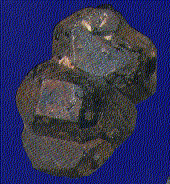 minerals - especially betafite [photo right, from
Silver Crater Mine] (a radioactive variety of the mineral
pyrochlore, which is a complex
calcium-sodium(uranium)-niobate-tantalate-hydroxide). It was
noted by Satterly that "Betafite [at the Silver Crater] is
often found in close association with clusters of mica books and
apatite crystals. Small crystals of betafite have been found
within the books of mica. (Satterly. 1956, p 130, emphasis
mine, See Figure 3a,b,c).
In my phone conversation with him in February (1987) Gentry
admitted that his samples contained betafite. Why did he leave
that observation out of his papers? Why is it, with so much
radioactive mineral and groundwater at these sites, there is very
little uranium in the halo centres? Or is there? Did Gentry err?
Some researchers think so (see Moazed and others, 1973).
minerals - especially betafite [photo right, from
Silver Crater Mine] (a radioactive variety of the mineral
pyrochlore, which is a complex
calcium-sodium(uranium)-niobate-tantalate-hydroxide). It was
noted by Satterly that "Betafite [at the Silver Crater] is
often found in close association with clusters of mica books and
apatite crystals. Small crystals of betafite have been found
within the books of mica. (Satterly. 1956, p 130, emphasis
mine, See Figure 3a,b,c).
In my phone conversation with him in February (1987) Gentry
admitted that his samples contained betafite. Why did he leave
that observation out of his papers? Why is it, with so much
radioactive mineral and groundwater at these sites, there is very
little uranium in the halo centres? Or is there? Did Gentry err?
Some researchers think so (see Moazed and others, 1973).
Clearly there is something complicated going on here, considering the nature of the host intrusive rocks, the low-grade metamorphism that the intrusive rocks have undergone, the high-grade metamorphism of the surrounding wall-rock, the hydrothermal activity and the metamorphic replacement by the biotite within the calcite vein-dikes. Gentry (1975. p. 270) states that "... the great majority of minerals containing polonium halos show no evidence of high temperature episodes" and further holds that the "halo coloration disappears within minutes in [the 300 degree Celsius] temperature range." He also states (on p 270) that:
"An equally strong objection to the uranium-daughter hypothesis in uranium poor (p.p.m. or less) minerals is that many Po halos (such as the ‘Spetacle' halo [from Silver Crater]) are located in the inferior of large pegmatite crystals as well as in small granitic mica flakes where they often more than 10 cm and sometimes much less than 100 cm away from a significant uranium source."
This is quite an extraordinary claim to make far four reasons.
- it contradicts Satterly`s observation that betafite occurs within some of the biotite;
- it shows that Gentry knows it is a pegmatite body and therefore MUST be intrusive;
- it admits that heat, like that from a metamorphic event, erases halos; and
- it acknowledges the proximity of radioactive minerals.
In our phone conversation in March of 1987, Gentry claimed that the sedimentary rocks cut by the dikes and pegmatites are "pristine", that they were created during creation week, and that they were later reworked during the Flood. He gives us a time frame for all this to occur in his book when he says (1986. p 129):
The Creator, after calling the chemical elements into existence, might well, in the next instant of time, have formed those elements into a liquid, and then immediately cooled that liquid so that it crystallized into the granites containing the polonium halos. These granites would have been created instantly and yet still show the characteristic of rocks that crystallized from a liquid or melt. (Gentry 1986, p.129)
Was then, the halflife of 218Po -just three brief minutes- the measure of time that elapsed from the creation of the chemical elements to the time God formed the granites? (1986, p. 32)
The question I ask is, why did Gentry choose 218Po's halflife of 3.04 minutes for this "measure of time," and not that of 210Po (of which these are the most abundant halos) at138 days or that of 214Po at .000164 seconds? Was this choice rationally, arbitrarily, or Biblically based? Regardless of which one, his argument is clearly an Omphalos argument, that is, one that postulates creation with an apparent past or age. In fact a look now at the whole Canadian Shield will indicate how much must have been created 'POOF style' with the appearance of age.